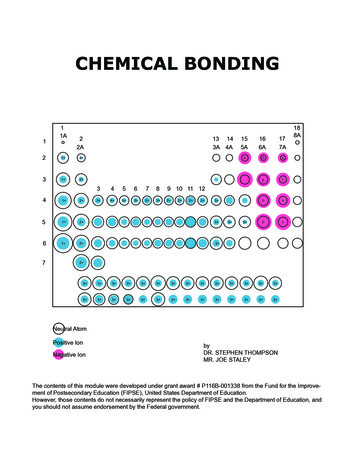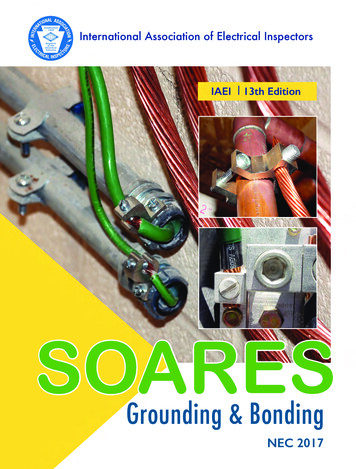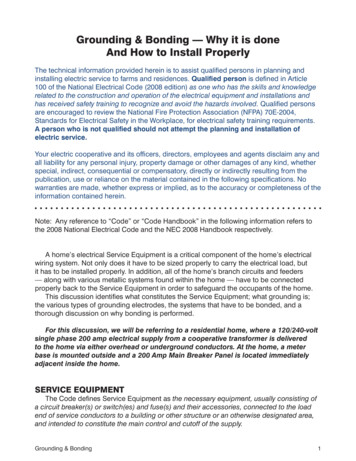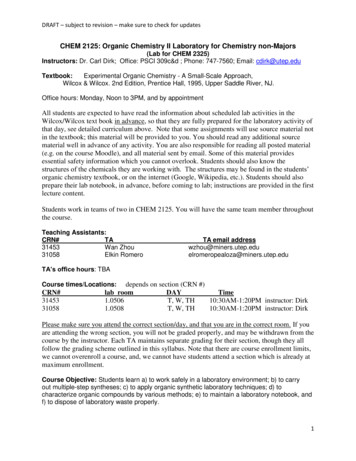
Transcription
CHEMICAL BONDING111A13 143A 4A22A21 2 31 2 3-3456789 10 11 123 4 5 3 2 3 2 41 2 51 2 3 61 2 3 7155A2 2 2 3 4 5 177A166A2-1-2-1-2-1-2-1-188A2 3 3 3 3 3 3 3 3 3 3 3 3 3 3 3 3 3 3 3 3 3 3 3 3 3 3 3 3 Neutral AtomPositive IonNegative IonbyDR. STEPHEN THOMPSONMR. JOE STALEYThe contents of this module were developed under grant award # P116B-001338 from the Fund for the Improvement of Postsecondary Education (FIPSE), United States Department of Education.However, those contents do not necessarily represent the policy of FIPSE and the Department of Education, andyou should not assume endorsement by the Federal government.
CHEMICAL lectronegativityRoad MapTypes Of BondingProperties Controlled By Chemical BondPolar BondsMetallic BondingIntermolecular ForcesIons: Counting Electrons And ProtonsIonic And Atomic RadiiIons And EnergyLithium FluorideCrystal PackingCrystal PackingCrystal PackingCovalent H2QuantizationBond Length And StrengthStrong And Weak BondsStrong And Weak BondsCovalent To MetallicElectron Delocalization
CHEMICAL loids22ALiGroup 18B0.82K3Mg1Ca4SrY0.79 0.89 1.1Cs0.7FrBaLa0.89 1.1Ra678910111.36 1.54 1.63 1.66 1.55 1.83 1.88 1.91 1.9ScTi0.82 0.95 1.22 A2.04 2.55 3.04 3.44 3.98Be0.93 1.31Na133ANonmetals0.98 pPuCuPd12C1.61 1.9AlSiNOF2.19 2.58 3.16PSCl1.65 1.81 2.01 2.18 2.55 2.96ZnGaGeAsSe1.93 1.69 1.78 1.96 2.05 2.1Ag2.28 2.54Cd2InSnSb2.04 2.33 2.02Te2BrI0NeArKr002.66 EsFmMdNoLrElectronegativity is the ability of an atom to attractshared electrons to itself.It is largely the difference between the electronegativities oftwo atoms which determines what kind of bond is formedbetween them.0He0RnWhat is the most electronegative element?What is the least electronegative element (aside fromthe noble gases)?What is the range of electronegativity for the metals?Metalloids? Nonmetals?Why is the electronegativity of the noble gases listedas zero?For an electron shared between hydrogen and chlorine,would you expect the electron to be closer to thehydrogen or the chlorine?2
CHEMICAL BONDINGROAD MAP3A 4A 5A 6A 7A 8A1A 2AHydrogenMetalsMetalloidsNonmetalsGroup 18HeHB C N O F NeLi BeAlCl ArV Cr Mn Fe Co Ni Cu Zn GaBr KrRb Sr Y Zr Nb Mo Tc Ru Rh Pd Ag Cd InI XeNa MgK Ca Sc TiCs Ba La Hf Ta W Re Os Ir Pt Au Hg Tl Pb Bi Po At RnFr Ra Ac Rf Ha Sg Ns Hs MtElectronegativityCe Pr Nd Pm Sm Eu Gd Tb Dy Ho Er Tm Yb LuTh Pa U Np Pu Am Cm Bk Cf Es Fm Md No LrIonicBondingGroups 1 and 2 MetalsNonMetals and HCovalentBondingNonMetals and HNonMetals and HPolarBondingOther MetalsNonMetals and HPolarBondingNon MetalloidsMetalloidsMetallicBondingMetalsMetals3
CHEMICAL BONDINGTYPES OF BONDINGThe different types of chemical bonding are determinedby how the valence electrons are shared among thebonded atoms.Filled electron shell coreValence Electron CloudIn IONIC BONDING the valence electrons are completely transferred from one atom to the other atom.Ionic bonds occur between metals and nonmetalswhen there is a large difference in electronegativity.Ionic BondingIn COVALENT BONDING the valence electrons areshared as pairs between the bonded atoms.Pure covalent bonding only occurs when two nonmetalatoms of the same kind bind to each other. When twodifferent nonmetal atoms are bonded or a nonmetal anda metal are bonded, then the bond is a mixture of covalent and ionic bonding called polar covalent bonding.Covalent BondingIn POLAR BONDING the electrons are shared butNOT equally. Many compounds have the characteristics of BOTH ionic and covalent bonding. Electronegativity differences determine the balance of character.Polar BondingIn METALLIC BONDING the valence electrons areshared among all of the atoms of the substance.Metallic bonding occurs when metals bond to eitherthemselves or mixed with other metals in alloys.Using the periodic table of electronegativities fromthe last page, write down examples of atom pairswhich you would expect to form covalent bonds,polar covalent bonds and ionic bonds.Metallic Bonding4
CHEMICAL BONDINGPROPERTIES CONTROLLED BY CHEMICAL BONDChemical bonding determines the physical propertiesof substances. These properties are listed below forcovalent, ionic and metallic bonding.CovalentGas, liquid, or a soft solid.Using the list of properties on the left, try to assignas many of the common substances in your environment to one of the types of bonding.Low melting point and low boiling point.Insoluble in H2OSoluble in nonpolar solvents.Nonconductor of heat and electricity.NonlustrousList and describe some substances which do notseem to fit into any of the three types of bonding.IonicCrystalline solid.Very high melting point.Soluble in H2O.Insoluble in nonpolar solvents.Nonconductor of heat and electricity.Conducts electricity in aqueous solutions.Examples: NaCl, CaCO3MetallicMalleable solid.High melting point and boiling point.Insoluble in H2O.Insoluble in nonpolar solvents.Conducts heat and electricity.LustrousExamples: gold, copper5
CHEMICAL BONDINGPOLAR BONDSIonic and covalent bonds are two ideal types.Many bonds share characteristics of both ionic andcovalent bonding. They are called polar covalentbonds and they tend to occur between atoms of moderately different electronegativities.In polar covalent bonds the electrons belong predominantly to one type of atom while they are still partiallyshared by the other type, as illustrated in the followingpictures of the valence electron densities.Separated AtomsValence electron(s)Filled electron shell coreIonic BondPolar Covalent BondCovalent BondUsing the chart of electronegativities, arrangethe following compounds in an order from mostionic to most covalent:Al2O3 , CaCl2 , NaF , O2 , NaCl,In the picture above, the separated atoms look alike.If, in fact, they are the same kind of atom, which ofthe three bonds shown is possible?Why only that one?What other type of bonding is possible betweenidentical atoms?6
CHEMICAL BONDINGMETALLIC BONDING‘ELECTRON SEA’ MODEL FOR METALSMetals are formed from elements on the left hand sideof the periodic table. Having generally low electronegativity they tend to lose their valence electrons easily.When we have a macroscopic collection of the sameor similar type of metallic atoms, the valence electronsare detached from the atoms but not held by any ofthe other atoms. In other words, these valence electrons are free from any particular atom and are onlyheld collectively by the entire assemblage of atoms.In a metal the ion cores are held more or less at fixedplaces in an ordered, or crystal, lattice. The valenceelectrons are free to move about under applied stimulation, such as electric fields or heat. e-e- e-e- e- e- e- e- e-1Picture 1 presents a regular arrangement of the ion coresfor a metal with a single valence electron per atom as wellas a snapshot of the location of the freely moving valenceelectrons.2 2 2 2 2 2 2 2 2 2Picture 2 shows a collection of ion cores for a metalwith two valence electrons. Draw in the valenceelectrons. (Little circles are good enough.)HINT: Metals are neutral in charge.What is the origin of electrical and thermalconductivity in sodium metal?Why do metals exhibit a wide range of melting points and hardness?7
CHEMICAL BONDINGINTERMOLECULAR FORCESIn addition to covalent, polar, ionic and metallic bonding there are intermolecular forces which contributeto the stability of things. These include dipole-dipoleforces, hydrogen bonding and London dispersionforces.DIPOLE-DIPOLE FORCESMany molecules are electric dipoles, that is, they havenet positive charge on one part of the molecule andnet negative charge on another part. Since oppositecharges attract and like charges repel, these moleculeswill tend to orient themselves so that there is the mostattraction and the least repulsion.Why is dipole-dipole interaction more important inliquids than in solids?Why is it more important in liquids than in gases?Can homonuclear diatomic molecules such as H2, O2and N2 have dipole-dipole forces?DIPOLE-DIPOLE INTERACTIONHYDROGEN BONDINGA particularly strong and important variety of dipoledipole interaction is called hydrogen bonding. Ahydrogen atom on one molecule is attracted to a highlyelectronegative atom in another molecule. Hydrogenbonding is strong both because of the high polarityinvolved and because the small size of the hydrogenatom permits a close approach between it and theelectronegative atomHYDROGENOXYGENHydrogen bonding is particularly noted between water molecules, but from the description given aboveyou should be able to deduce other substances inwhich hydrogen bonding occurs.HYDROGEN BONDINGLONDON DISPERSION FORCESEven nonpolar molecules have a random fluctuationof charge making the molecule temporarily polar. Thisthen induces an opposite fluctuation in a neighboringmolecules so that the two molecules have oppositecharges on their near sides and attract each other.inducedctm effequantuorF-FF-Fquantum effectinduced8WATERMOLECULE
CHEMICAL BONDINGIONS: COUNTING ELECTRONS AND PROTONSNEUTRAL ATOMSNeutral atoms have the same number of electrons asprotons. In the picture below, the nuclear charge isrepresented by the gray circle marked 3 , for the 3protons in the nucleus of lithium. Electrons are markedas horizontal dashes, one for each electron.POSITIVE IONSPositive ions have more protons than electrons.Since the number of protons an atom has is fixed inordinary chemical reactions, positive ions are producedby removing electrons from the atoms.Li Li3 3 In the pictures below draw in the number of electronsneeded to make the ion named in the box.In the pictures below, draw in the number of electrons required to make the atom neutral and write theelement symbol in the box to the left of the atom.Na 11 Mg2 12 8 9 NEGATIVE IONSNegative ions have more electrons than protons.Since the number of protons is unchanged from the neutralatom, negative ions are formed by the addition of electrons.In the pictures below draw in the number of electronsneeded to make the ion named in the box.11 O2-8 F-9 17 9
CHEMICAL BONDINGATOMIC AND IONIC RADIINeutral AtomPositive IonNegative Ion111A13 143A 4A22A21 2 31 2 3-3456789 10 11 123 4 5 3 2 3 2 41 2 51 2 3 61 2 3 7155A2 2 2 3 4 5 177A166A2-1-2-1-2-1-2-1-188A2 3 3 3 3 3 3 3 3 3 3 3 3 3 3 3 3 3 3 3 3 3 3 3 3 3 3 3 3 In this version of the periodic table the relative sizesof both neutral atoms and of their most common ionsare shown, as well as the charges on their ions. Theatoms are shown as black outline circles and the ionicdiameters are colored blue for positive ions and red fornegative ions.What makes the atoms and ions in the middle of periods 4, 5 and 6 so small? What makes the samariumatom so large?Identify the two kinds of atom which appear about thesame size as their ion and explain why this is so.Why are the positive ions smaller than their neutralatoms while the negative ions are larger than theneutral atoms?Why are the antimony and beryllium ions so small?Differentiate between the causes.Why are the Lanthanide ions of such similar size?Why do both ions and atoms tend to grow larger aswe go down the periodic table?How might you use the chart of atomic and ionic radiito explain the strengths of ionic bonding betweenvarious ions?What is the smallest atom? What atom has thesmallest ion (too small to show on the table)? Findthe largest atom and identify it on a standard periodictable.Compare the ionic and atomic radii table above withthe chart of electronegativities and attempt to explainas many aspects of the sizes of atoms and ions interms of electronegativity as possible.What kind of ions do atoms with large electronegativities tend to form?10
CHEMICAL BONDINGIONS AND ENERGYeAdd Energy00e- The diagrams above show the ground state of thelithium atom, followed by an excited state, followedby the lithium ion with the free electron. What is thecharge of the lithium ion in the right hand drawing?In the diagrams above, draw in the electrons as arrows which occupy the ground state orbitals of thesodium atom in the left hand picture. In the righthand picture draw in the orbitals and electrons of thesodium ion.e-e00 0ENERGYENERGY0ENERGY0 0ENERGYENERGY0Add More Energy Energy The diagrams above show the ionization of fluorine.What is the charge of the fluoride ion?In the diagrams above, draw in the electrons (arrows)for the chlorine atom on the left and for the chlorideion on the right. What is the charge of the chlorideion?11
CHEMICAL BONDINGLITHIUM FLUORIDE2Li(s) 2Li(g)It requires 155 kJ/molto separate lithium atomsfrom their body centeredcubic crystalstructure.2Li(g) 2Li (g) 2e-(g)It requires 520 kJ/molto ionize lithium atoms.e LiLi Add the energies which areassociated with the processa making lithium fluoridecrystal lithium crystal anddifluoride molecules. Is thenet reaction endothermic orexothermic? F2(g) 2F(g)It requires 80 kJ/molto dissociate the difluoridemolecule. e-2F(g) 2e-(g) 2F-(g)Ionization of the fluorineatom gives off 328 kJ/molof energy. F-F2Li (g) 2F-(g) 2Li F-(s) – Combining the lithium andfluoride ions into their crystalgives off 1030 kJ/mol ofenergy.12Li
CHEMICAL BONDINGCRYSTAL PACKINGThe picture at left shows sevenspheres packed as close together as possible in the plane.This is called close packing.How many gray spheres touchthe green sphere?1Using circles, sketch in the box above another way totile the plane.2The picture above shows how close packing canfill, or tile, the plane. Notice the little triangles (withcurved sides) that lie in between the spheres. Someof them point up and some of them point down.Compare the number of each kind of triangle.Picture 3 is simply picture 2 looked at through an angle.3Picture 4 shows the spheres of picture 3 topped byanother plane of spheres set to fit as closely as possible into the lower plane. For clarity, the second planeis semitransparent green with a black outline.4Picture 5 shows the same planes of atoms as in picture 4 but viewed from above. What proportion of thetriangular spaces between the spheres of the lower(grey) plane are occupied by the second (green)plane of spheres?513
CHEMICAL BONDINGCRYSTAL PACKINGPicture 6 shows the sametwo layers as picture 5but two different sets ofspaces between the greenspheres of layer 2 aremarked either red or blue.We can construct a thirdlayer by placing sphereseither in the blue spacesor the red spaces.Why can we not use both the red and the bluespaces for placing the layer 3 spheres?6Notice that the blue spaces lie directly above the greyspheres of layer 1. If we use these spaces for layer 3then we get a two level repeating structure. If we namelayer 1 A and Name layer 2 B then we can describe thestructure as ABABAB.This is called hexagonal close packing or hcp for short.Alternatively we can place the third layer of spheresin the red spaces. Then the third layer is differentlylocated than either of the first two and is named C. Wecan describe this structure as ABCABC.It is called cubic close packing or ccp.7hcp8ccpUsing colored pencils, pens or crayons, draw circlesrepresenting the hcp structure in the box above.Using colored pencils, pens or crayons, draw circlesrepresenting the ccp structure in the box above.14
CHEMICAL BONDINGCRYSTAL PACKINGIn the box below, you draw a bcc structure for 13atoms.910Here you see another packing structure in which eightatoms are located at the corners of a cube and a ninthatom is at the center of the cube. This is called bodycentered cubic, or bcc. Picture 9 shows a space fillingmodel and picture 10 shows a ball and stick model.Using spheres, such as marbles, bbs, ping pongballs, etc. experiment with hcp, ccp and bcc packing in order to determine which is the most efficientpacking, i.e., which can get the most spheres into thesame space.As you can see in the table below, the metals havepacking structures which are related to their places inthe periodic table. bccComparing the packing structures of the metals totheir electronegativity, do you find any relationship? hcp RhPdAgCdInSnCsBaLuHfTaWReOsIrPtAuHgTlPbAl15
CHEMICAL BONDINGCOVALENT H2HydrogenAtomConfining electrons makes them ‘dance’. This is partof quantum theory. The tighter electrons are squeezedthe harder they dance. Dancing electrons have kineticenergy. But electrons will slow down if they can. Whenthey have more room they can slow down, whichmeans they have less kinetic energy.In a hydrogen molecule the electrons can move throughthe space of two atoms instead of one, which meansthat they have more room and thus can dance slowerand have less kinetic energy. (Picture 1)There are also electric attractions and repulsions betweenthe particles in the molecule. Picture 2 shows therepulsions of like charges as colored arrows and theattractions of opposite charges as black arrows.The additive combination of the electric and kineticenergy effects gives the covalent bond for hydrogen.PotentialEnergyDIHYDROGEN MOLECULEInternuclear DistanceENERGYSuppose you have two well separated hydrogen atomsand begin moving them closer together. From thepicture aboveyou can see that the energy of the systemwill decline as they are being moved together until atsome distance the system will have a minimum energy.What causes to energy to rise as the atoms aremoved closer than the minimum energy?A dihydrogen molecule consists of two hydrogen nuclei(protons) held a fixed distance apart and surrounded bya probability density cloud of two electrons.As you can see from the picture above, the separation is that at which the system is in the state of lowestenergy. But what are the factors which cause this to bea low energy state?There are primarily two factors. They are quantum andelectrostatic effects.Quantum theory produces two effects, lowered energyand discrete energy levels.HHH2DISTANCE1 216
CHEMICAL BONDINGQUANTIZATIONThe red electron cloud represents the probablelocation of the electrons. Notice that the space forelectrons is larger in the H2 molecule than it is in theseparated hydrogen atoms.Just below we show two hydrogen atoms and theircombination as H2 on the right.e ENERGYENERGY eeezero energy211One of the basic principles of quantum mechanics isthat whenever anything is confined in a finite space, itcan only occupy one of a discrete set of energy levels.It is also the case that when the space is made largerthe energy states are lower.In picture 1 the blue lines represent the energy statesavailable for a particle confined between the orangewalls.In picture 2 the blue lines show how the energy statesare lower when the particles are given more space.Which picture, number 1 or number 2, has the lowesttotal energy?If picture 1 represents the energy states of twoseparate hydrogen atoms, then what could picture 2represent?These pictures do not necessarily show that if youmove two hydrogen atoms close together they will bondto form a hydrogen molecule but they do show that thehydrogen molecule will be at a lower energy state thanthe combined energies of the separate atoms and thatyou would need to add energy to the molecule to getthe atoms separated and that therefore the moleculewill hold together until you add that energy.Now that we know why covalent bonding occurs we willuse simplified pictures known as overlapping orbitals todescribe more complicated molecules. Just to the rightwe show this model for hydrogen. 17
CHEMICAL BONDINGBOND LENGTH AND STRENGTH1200 kJ/mol600 kJ/mol900 kJ/mol300 kJ/mol50 pm100 pm150 pm1200 kJ/mol200 pm900 kJ/mol0600 kJ/mol250 pmBOND STRENGTH300 kJ/mol300 pmBOND LENGTHH HH ClH CC CC CC CC OC OC ON NN NN NF FCl ClBr BrIICFC ClC BrC I50 pm100 pm150 pm200 pm250 pm300 pm0Which are the longest and shortest bonds shown?Which are the strongest and weakest bonds shown?In each group of related compounds, what correlation do you observe between bond length and bondstrength?What are some exceptions?18
CHEMICAL BONDINGSTRONG AND WEAK BONDSkJ/mol05001000150020002500300005101535004000 kJ/molMgOCaOMgCl2CaCl2LiFNaFKClNNCCC CO OHFO HC HN HNCF FWHgIonic Lattice EnergyCovalent Bond EnergyMetallic Lattice EnergyIntermolecular Bond EnergykJ/molIon-Permanent DipoleHydrogen BondingPermanent Dipole-Permanent DipoleH 2OHClPermanent Dipole-Induced Dipole HCl–ArInduced Dipole-Induced DipoleHe1920 kJ/mol
CHEMICAL BONDINGSTRONG AND WEAK BONDS1000 kJ/molNaFN NSTRONG BONDS900 kJ/molA.IonicMuch of the strength of ionic bonding comes about whenthe ions are packed together in crystal lattices, so thateach ion is held in an attractive field with several neighbors of the opposite charge. These binding energiescan range up to several thousand kilojoules per mole.CNWC C800 kJ/molB.CovalentCovalent bonds are also strong, ranging up to 940kilojoules per mole for triple bound N2.700 kJ/molC.MetallicMetals are also strongly bonded, as you can deducefrom their strength and hardness, although the liquidmetal mercury is an exception.600 kJ/molNaCl C OKClMgCl2LiClC CWEAK BONDSWeak bonds, often called intermolecular forces, areseveral orders of magnitude weaker that strong bondsdescribed above. One of the relatively stronger of theweak bonds is hydrogen bonding with energies rangingfrom two to ten kilojoules per mole.500 kJ/molO OSi–Cl400 kJ/molC–HC–OC–CD.Ion-Permanent DipoleThese would include salts dissolved in a polar substance, e.g., NaCl dissolved in water.300 kJ/molNaNO3 C–N200 kJ/molN–OE.Permanent Dipole - Permanent DipoleThis class of bond includes hydrogen bonding.F.Ion - Induced DipoleG.Permanent Dipole - Induced DipoleO–OH.Induced Dipole - Induced DipoleThese are also known as van der Waals forces or asLondon dispersion forces. They are quite weak butthey always exist between nearby molecules and theyare always attractive.100 kJ/molHg10 kJ/molA20BCD, E, F, G, H
CHEMICAL BONDINGCOVALENT TO METALLICWhile we have a simple gradation between ionic andcovalent compounds, we are also able to find a pathof bonding types which goes from covalent to metallic bonding. This is not a simple gradation but ratherdetours through the network covalent bonds, some ofwhich are semiconductors.Electrons can only be located in space with a probability density, but we can also locate electrons with regardto their situation with respect to other entities.For example, there are free electrons which are notbound to any atom or molecule but are pushed aboutby electric and magnetic fields. On earth, they usuallydo not remain free very long but end up (at least for awhile) in one of the following situations.Our essential procedure in tracing the connectionsbetween these types of bonding is to follow the valenceelectrons.In covalent bonding the bonding pairs of electronsare held in distinct orbitals, even though their physicallocation is, as always, given by a continuous probabilitydensity.Several atoms, both like and unlike, can be connectedpair-wise together by covalent bonds and large molecules, particularly organic, can be constructed this way.However, we also begin to see phenomena other thanpair wise bonding between definite atoms appearing.An example is ozone, O3 , a linear molecule in whicheach of the outer atoms is bonded to the central atomequally, but with both of them sharing three bondsbetween them. In this case the individual electronscannot be assigned to a definite bond and are said tobe delocalized.There are some types of atoms, such as carbon andsilicon, where covalent bonds form between unlimitednumbers of the atoms. In the graphite form of carbonthree of the bonding electrons of each carbon atomform covalent bonds between neighboring atoms toform a hexagonal planar structure, but the fourth bonding electron sticks out between planes. These bondsoverlap and connect the planes together and they arealso delocalized, which means that these electrons arefree to move around under, say the pressure of an electric field and thus graphite is an electrical conductor.Finally, in metals, all of the valence electrons are heldcommunally by the whole substance and are thus freeto conduct electricity or heat.There are also more extreme cases of delocalizationthan metals. These include superconductors and thenew Bose-Einstein condensates.Describe the location , stability and energy level of anelectron in each of the situations listed below.An electron in an atomic orbital.An electron in a subshell.An electron in a shell.A valence electron.An electron in a filled shell.An electron in an atom.An electron in an excited state.An electron in a negative ion.An electron in a positive ion.An electron in a molecular orbital.A valence electron in a metal.A valence electron in a superconductor.An electron in a Bose-Einstein condensate.21
Polar Covalent23CovalentO2Bondingelectronpairs aresharedequally byboth atoms.CHEMICAL BONDING1LocalizedIonicCOH 2OCO2CsF NaClBonding electronpairs clusteraround the mostelectronegativeatom(s).4C 6H 6Molecular OrbitalsO3Some bondingelectrons areheld collectively inside themolecule.ELECTRON DELOCALIZATION5Semi-metallic6GoldMetals7All the valenceelectrons are freeto move withoutresistance.K3C60 at 19KSuperconductorsIn a Bose-Einsteincondensate allof the electronsbecome part of asingle ‘atom’.Rb at eAll valenceelectrons arefree to movethroughoutthe lattice.9SiIn graphite,valence electrons are freeto move in twodimensions.8A small proportion ofthe electrons are freeto move about thelattice.7Electronsare held byeach atomin completedshells.4In the picture at right, thegray circles represent thecore of filled shells whilethe red cloud is the set ofvalence or conducting electrons held in common bythe metal. Compare andcontrast with number nine.1In Benzene six of thebonding electrons areheld collectively by themolecule as a whole. Inthe picture these are represented by the red cloud.8Cl5Na2In a semiconductor, suchas Silicon, a small minorityof valence electrons arefree to move about thelattice.The free electron is shownas the small red blur atright.9Cl-When two atoms of moderately different electronegativity are bound, the binding electrons are sharedunevenly, tending towardthe more electronegativeatom.6Na 3In the picture at right, thesmall grey dots representthe separate nuclei. Thered cloud represents all(not just the valence) electrons held in common bythe substance, as if it wereone atom.Filled shells are shownin grey.Valence electron cloudsare in red.Negative ions are outlined in red.Positive ions are outlined in blue.In a homonuclear diatomicmolecule the binding electronpairs are shared evenly andsymmetrically by both atoms.In graphite the carbonatoms are bound in hexagons that are arranged insheets. The sheets areloosely bound to eachother and the electronsbetween the sheets arefree to move.22
High melting point and boiling point. Insoluble in H 2 O. Insoluble in nonpolar solvents. Conducts heat and electricity. Lustrous Examples: gold, copper Ionic Crystalline solid. Very high melting point. Soluble in H 2 O. Insoluble in nonpolar solvents. Nonconductor of heat and electricity











